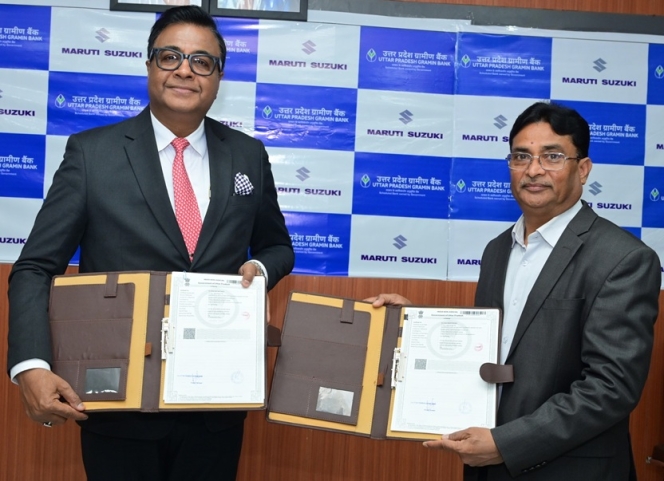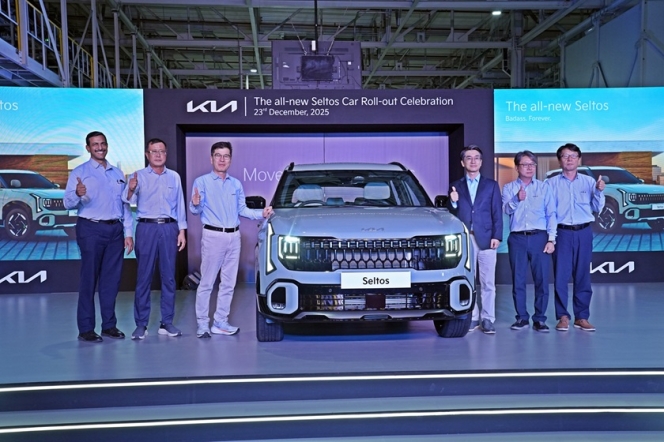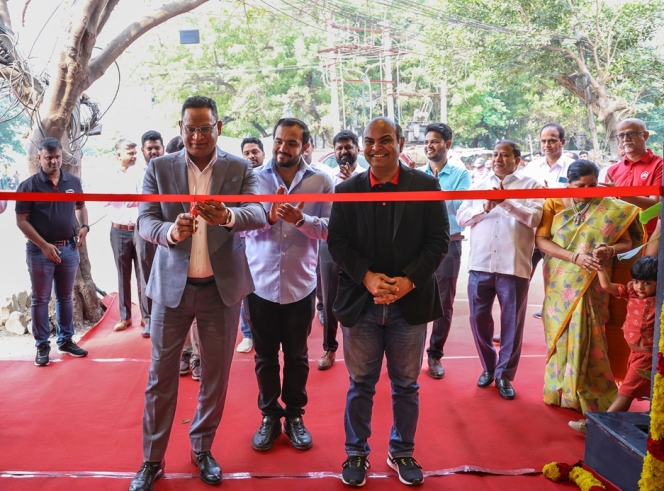C5 Aircross Heralds Citroen’s Journey In India
- By T Murrali
- April 11, 2021

According to the company, C5 Aircross SUV is introduced in India after rigorous testing of the vehicle for over 2.5 lakh kilometres on different terrains and varied weather conditions across the country. Globally, the brand is illustrated by its unique comfort signature accomplished by five key objectives of the brand’s refined comfort, defined in the new vehicle. These include the flying carpet effect - for cushioning the discomfort from road bumps through the progressive hydraulic cushion equipped suspension system, exclusively developed by the vehicle maker.
 Comfortable interiors – for a stress-free travel environment, the design cocoons the occupants in comfort with an acoustic windscreen & front window glasses, advanced comfort seats with memory foam. It offers panoramic life with a brighter and airier cabin and panoramic (only in the top-end variant) sunroof.
Comfortable interiors – for a stress-free travel environment, the design cocoons the occupants in comfort with an acoustic windscreen & front window glasses, advanced comfort seats with memory foam. It offers panoramic life with a brighter and airier cabin and panoramic (only in the top-end variant) sunroof.
 Intuitive Technologies - to simplify life on board through its offerings including grip control system with multiple drive surface options, blind-spot monitoring system, park assist feature which enables parking of the car with only the brake and accelerator control while the car steers itself. Besides, the engine stop & start function help conserve fuel. It has a 12.3-inch digital driver display, an 8-inch infotainment touchscreen with a phone mirroring function. These are fuelled by the 2.0-litre diesel engine and 8-speed automatic transmission with shift and park by wire control, giving a comfortable drive.
Intuitive Technologies - to simplify life on board through its offerings including grip control system with multiple drive surface options, blind-spot monitoring system, park assist feature which enables parking of the car with only the brake and accelerator control while the car steers itself. Besides, the engine stop & start function help conserve fuel. It has a 12.3-inch digital driver display, an 8-inch infotainment touchscreen with a phone mirroring function. These are fuelled by the 2.0-litre diesel engine and 8-speed automatic transmission with shift and park by wire control, giving a comfortable drive.
Well, does the car offer all that the manufacturer has promised? To check this out, we took a spin recently on a stretch that has a mix of traffic, a reasonable rough patch and a highway.
 Though a host of technologies offers the occupants’ comfort, the prime amongst them is the progressive hydraulic cushions, which is different from the suspension system in other cars in the same segment or below. These specialised suspension systems are primarily used in high-end cars, and the speciality is that, unlike the conventional suspension system having shock absorbers, springs, and mechanical stops, the system offered by Citroen has two progressive hydraulic cushions – one at the top and the other at the bottom – for rebound and compression.
Though a host of technologies offers the occupants’ comfort, the prime amongst them is the progressive hydraulic cushions, which is different from the suspension system in other cars in the same segment or below. These specialised suspension systems are primarily used in high-end cars, and the speciality is that, unlike the conventional suspension system having shock absorbers, springs, and mechanical stops, the system offered by Citroen has two progressive hydraulic cushions – one at the top and the other at the bottom – for rebound and compression.
 While driving on normal surfaces, the shock absorbers and springs control vertical movement without progressive hydraulic cushions. In potholes and rough patches, the shock absorbers and springs work together with the progressive hydraulic cushions.
While driving on normal surfaces, the shock absorbers and springs control vertical movement without progressive hydraulic cushions. In potholes and rough patches, the shock absorbers and springs work together with the progressive hydraulic cushions.
As they are located at both the ends of the vehicle’s suspension travel, they help cushion slow movement more gradually than a conventional mechanical stop. In the conventional system, the absorbed energy is partially returned, giving discomfort to the vehicle’s occupants.
In the case of progressive hydraulic cushions, the absorbed energy is dissipated due to dual hydraulic cushions, eventually delivering a ‘magic carpet ride’ for the C5 Aircross. Besides, specific design, structural bonding and seats amply the comfort inside the car.
The first impression that the car gives when onboard is comfortable seating for the driver and other occupants. A thick, textured foam flown over the high-density foam at the surface makes the seat really comfortable. Three separate seats are provided in the rear with individual tracks to move forward and backwards. In addition to seats, clear outside view for the driver that is accentuated by the cut-glass beyond the C-pillar.

The clean dashboard with the infotainment system gives a nostalgic feeling of a component system or deck with a turntable, amplifier and cassette player sandwiched between two towers of speakers boxes. There is enough storage in the car – about 36 litres, in addition to 580L boot space; 720L when the rear seats moved forward and 1,630L with the modular rear seats folded away. The boot can be opened by moving your foot under the rear bumper and close with the touch of a button.
Citroen has gone one step ahead in providing even aircon controls in the touchscreen. Though it may be a good innovation to remove a cluster of knobs from the dashboard, it may not give the touch and feel of the knob, which does not need the driver’s attention to divert it to control, while is it not the case in the touch screen.
The DNA of an SUV is to take varied and challenging surfaces in its stride. The Citroën C5 Aircross SUV does precisely that with grip control, which provides secure traction in all conditions, through five modes – standard (ESC), snow, all-terrain (mud, damp grass, etc.), sand and traction control off – that you can select instantly using a dial on the centre console. Besides, it has a hill descent assist feature.
The exterior looks are different and pleasing, which makes the vehicle a head-turner. The feminist looks may attract many women customers as they would like to be behind an SUV’s wheels.
Though the company claims that the vehicle is meant for India, it was not evident on several fronts:
1. Like the other European and American vehicles, the C5 Aircross maintained the turn indicator lever on the left and the wiper on the right.
2. The bonnet opening lever is placed near the front door hinges of the left-hand side. This is not easy while entering star hotels and other secured areas as they expect to open the bonnet for security checks. While driving alone, the driver has to either step out and go to the co-passenger side, open the front door, lift the lever or he or she may have to seek others help to open it.
3. The vehicle is assembled at the company’s Chennai plant with SKD kits that comprise painted body shells. The kit includes even tyres, seats and battery, that can be easily localised. These will inflate the cost.
Still, the new brand - Citroen and its new SUV C5 Aircross can make it in the Indian market provided it satisfies the customers on all fronts.

La Maison Citroën
Citroën is ready for India with the launch of “La Maison Citroën” phygital showrooms. La Maison Citroën will disrupt the codes of traditional automobile distribution. It is a ‘feels like home’ comfort experience with its warm, friendly and colourful ambience. A giant screen placed on the façade attracts passers-by, encouraging them to walk inside. The warm interiors featuring a natural wood finish and colourful inscriptions invite customers to experience the Citroën brand and its century-old legacy.
A full digital ecosystem will link seamlessly the digital experience of customers and enrich the showroom’s journey with ATAWADAC - AnyTimeAnyWhereAnyDeviceAnyContent - with High Definition 360° 3D Configurator reception Bar, high definition 3D configurator, Citroen Origins touchscreen.
As part of the 360° Comfort strategy for India, Citroën will offer a range of services, including attractive finance and leasing services through Citroën Finance and Insurance and 30-minute Guaranteed Trade-In facility.
L’Atelier Citroen, the aftersales workshop, will offer innovative services including Anytime Anywhere, Access and Virtual Remote Diagnostics. (MT)
Citroen India Delivers 51 C3 CNG Vehicles To Luthra Group
- By MT Bureau
- December 24, 2025
Citroen India, in partnership with its dealership La Maison Nanavati, has completed the handover of 51 Citroen C3 CNG vehicles to the Luthra Group. The ceremony took place at the Luthra Group’s headquarters in Surat.
The delivery is part of Citroen's strategy to expand its presence in tier-II and tier-III markets by providing mobility solutions to businesses and individuals.
The Citroen C3 CNG is designed for high-usage environments and daily commutes. The model includes several features tailored for the Indian market, integration of a factory-fitted CNG kit to manage running costs. A suspension system tuned specifically for local road conditions. Provisions for cabin space and air-conditioning systems designed for high-ambient temperatures.
The handover to Luthra Group represents the brand's focus on cost-efficient transportation. By targeting the regional business sector, Citroen India aims to strengthen its footprint in Gujarat and the broader Indian mobility market.
The C3 CNG is positioned as a solution for users requiring reliability and low operating expenses without compromising on ride comfort.
Maruti Suzuki India Partners Uttar Pradesh Gramin Bank For Retail Financing
- By MT Bureau
- December 24, 2025

Maruti Suzuki India has signed a Memorandum of Understanding (MoU) with Uttar Pradesh Gramin Bank, a regional rural bank, for vehicle retail financing partnership on new cars, pre-owned vehicles and commercial vehicles.
This collaboration marks the 50th retail finance partner for Maruti Suzuki India. The partnership is intended to use the bank’s network to provide credit options to a range of customer profiles, particularly in rural and semi-urban regions.
The partnership aims to increase the accessibility of Maruti Suzuki products through, tailored finance schemes designed for rural and regional customers.
Partho Banerjee, Senior Executive Officer, Marketing & Sales, Maruti Suzuki India, said, “Our partnership with Uttar Pradesh Gramin Bank marks a significant milestone as we onboard our 50th retail finance partner. This reinforces our commitment to making car ownership simpler and more affordable for customers across India. By expanding our reach through this strategic alliance, we aim to empower buyers with competitive, customer-friendly financing solutions that enhance the overall purchase experience. We remain focused on delivering seamless, tailored finance options, and this collaboration strengthens our vision of providing the Joy of Mobility to aspiring Indian consumers.”
Yadav S. Thakur, Chairman, Uttar Pradesh Gramin Bank, said, “At Uttar Pradesh Gramin Bank, empowering customer aspirations is at the heart of everything we do. Our partnership with Maruti Suzuki, a leader in the automotive industry, is a strategic step towards enhancing our service offerings and delivering greater value to our customers. This collaboration aligns with our 'Customer-First' mission, enabling us to provide accessible and affordable vehicle financing solutions. We look forward to helping more individuals and families across the country realise their dream of owning a Maruti Suzuki vehicle.”
Kia India Commences Production Of New Seltos In Anantapur
- By MT Bureau
- December 23, 2025

Kia India has started production of the latest generation Seltos at its manufacturing facility in Anantapur. The company has confirmed that prices for the mid-SUV will be announced on 2 January 2026.
The Anantapur plant, established in 2019, serves as a hub for both the Indian domestic market and international exports. The facility uses automation and a local workforce to manufacture the Seltos, which was the first model produced by the company in India.
The new model is built on Kia’s K3 platform, which has been engineered to increase structural rigidity and improve suspension damping. The vehicle has grown in size compared to its predecessor to increase cabin space and stability. It has 4,460 mm of length, 1,830 mm of width and a wheelbase of 2,690 mm.
The exterior design follows the ‘Opposites United’ philosophy, featuring a ‘Digital Tiger Face,’ LED projection headlamps, and alloy wheels with neon brake callipers.
The vehicle integrates several digital interfaces and driver assistance systems. It features an upgraded Kia Connect 2.0 suite with over-the-air (OTA) software updates and a proximity unlock function.
In terms of safety, it gets 24 features as standard, while ADAS Level 2 offers 21 autonomous features to assist the driver. The Kia Seltos SUV comes with three engine options – 1.5-litre Petrol producing 115 PS of power and 144 Nm of torque, 1.5 T-GDI Petrol producing 160 PS of power and 253 Nm of torque and a 1.5-litre diesel engine producing 116 PS of power and 250 Nm of torque.
Transmission choices include a 6-speed manual (6MT), intelligent manual (6iMT), IVT, 7-speed dual-clutch (7DCT) and a 6-speed automatic (6AT). The model will be sold in four trims – HTE, HTK, HTX and GTX – with additional option variants and an X-Line styling pack.
Gwanggu Lee, Managing Director & CEO, Kia India, said, “The roll-out of the All-New Kia Seltos marks a proud milestone for Kia India. Seltos has long set benchmarks in the mid-SUV segment, and this new generation represents a bigger, bolder, and more progressive evolution shaped by insights from Indian customers. With production now underway at our Anantapur facility, our teams are fully geared to ensure customers can take delivery of their all-new Seltos without long waiting periods. We are confident the all-new Seltos will once again redefine expectations in the segment and strengthen Kia’s leadership in India."
“The new Seltos looks fantastic. The Anantapur team, together with our supplier partners, have done an outstanding job in delivering our customers a great looking, significantly bigger, technologically progressive and safe vehicle with impressive functionality and connectivity,” he said.
- Citroen India
- Jeep
- Stellantis
- Citroen 2.0
- Shailesh Hazela
- Kumar Priyesh
- Sree Venkata Teja Kethineni
- VTK Automobiles
Citroen India Opens 126th Outlet In Chennai Under Citroen 2.0 Strategy
- By MT Bureau
- December 23, 2025

Stellantis-owned French automotive brand Citroen India has inaugurated its 126th point of sales and service (POS&S) facility in Chennai, continuing the expansion of its network under the ‘Citroen 2.0 – Shift Into The New’ strategy.
The new 3S (Sales, Service and Spares) facility is located at Chitlapakkam, near Chrompet. It is an extension of the partnership with VTK Automobiles, which now operates five Citroen touchpoints in the city. The outlet functions as a ‘Stellantis Brand House,’ allowing customers to access both Citroen and Jeep brands within a single space.
Since the announcement of the Citroen 2.0 strategy, the brand has increased its network by 48.6 percent. Over the last six months, the company added 43 points of sale through its network expansion programmes. Citroen expects to reach a total of 135 outlets by the end of the year, with further operations planned for the north, west, and east of India.
The strategy focuses on several pillars – deepening the domestic supply chain for India-centric products. Expanding the dealer footprint into Tier 2 and Tier 3 locations. Using digital tools and unified spaces for sales and aftersales services.
Shailesh Hazela, CEO and Managing Director, Stellantis India, said, “The expansion of Stellantis network further with VTK dealership in Chennai marks another important step in Citroen and Jeep India’s network growth strategy. Chennai is a key market for us, and this upgraded facility will enable us to serve our customers better with a seamless sales and ownership experience. Aligned with our Citroen 2.0 strategy, we remain committed to strengthening our dealer partnerships and building a robust, customer-centric network across the country.”
Kumar Priyesh, Director Automotive Brands, Stellantis India, said, “We have grown our network by almost 48.6 percent since we announced the Citroen 2.0 strategy and have been able to expand our operations in different parts of country: adding tier 2/3 locations while further strengthening in Metro/ Tier 1 cities. Through project Visitar, Network Expansion Program and expansion in new geographies we added over 43 POS in the last 6 months and are already in advanced stages to start additional operations in North, West and Eastern parts of the country and expected to close the year with 135 POS for Citroen.”
Sree Venkata Teja Kethineni, Dealer Principal, VTK Automobiles, said, “We’re happy to partner to this pivotal shift in automotive retail, proudly representing Jeep and Citroen. Our dual-brand strategy empowers us to deliver a truly elevated and distinctive experience – whether customers seek rugged performance or refined sophistication. With passion, professionalism and personalised care at the core, our team is committed to exceeding expectations and upholding the global standards these iconic brands represent.”
The facility includes a service centre equipped with diagnostics and digital tools. Staff members are trained across both Jeep and Citroen product lines to provide technical support and product information.






Comments (0)
ADD COMMENT